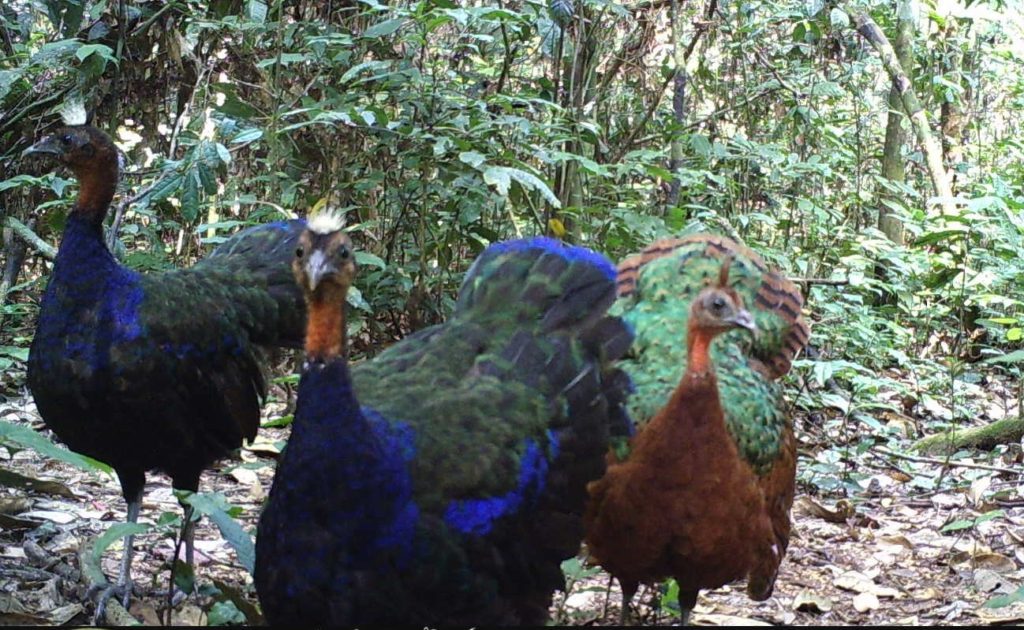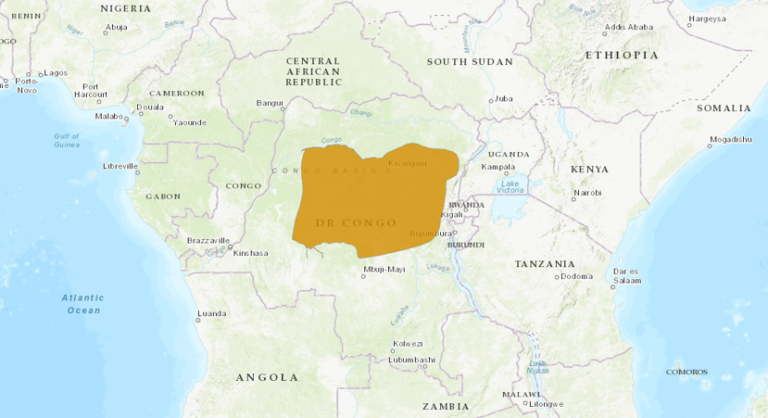Birdfinding.info ⇒ Shy and rarely seen, but apparently remains widely distributed in intact forests across the northern half of the D.R.C. The most reliable sites are reportedly Maiko, Kahuzi-Byeqa, Lomani, and Salonga National Parks, and the Okapi Wildlife Reserve and adjacent areas in the Ituri Forest.
Congo Peafowl
Afropavo congensis
Endemic to the Democratic Republic of the Congo, where it occurs in rain forest from lowlands up to around 1,200 m.
Full extent of distribution is not well-documented, but surveys have detected it in several areas of mostly intact forest across much of the Congo Rainforest from the Congo River east to the Ituri Forest and foothills of the Albertine Rift Mountains, and south to the Kasai River and Itombwe Uplift.
Total population has been estimated at between 3,750 and 15,000, and declining, but the infrequency of detections makes estimates very approximate.
Identification
A turkey-sized, short-tailed relative of the Asian peafowl that more closely resembles a guineafowl in shape.
Male has blackish head, neck, and underparts, with violet and indigo iridescence, and blackish- to brownish-green upperparts.
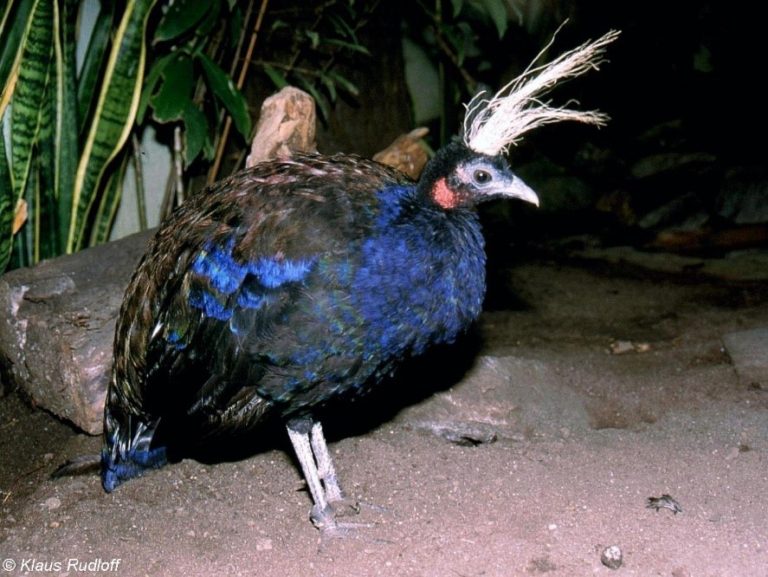
Congo Peafowl, male with a very long topknot. (Frankfurt Zoo, Germany; July 16, 2000.) © Klaus Rudloff
The male has a distinctive topknot crest of whitish, hairlike bristles—though in some cases a portion of the bristles are black.
The facial skin is often bare and grayish, with a bare red throat patch that extends down the front of the neck.

Congo Peafowl, male with very short topknot. (Artis Zoo, Netherlands; September 7, 2008.) © Arjun Haverkamp
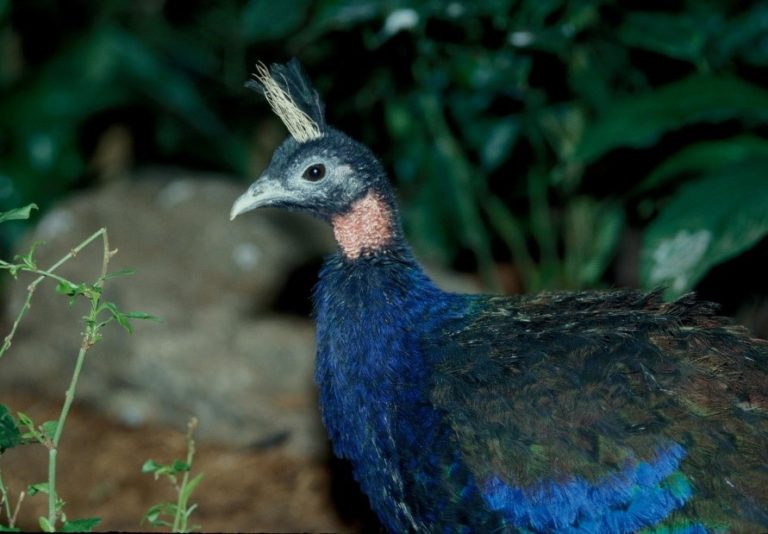
Congo Peafowl, male with bicolored topknot. (Bronx Zoo, New York; February 23, 1993.) © Marvin Hyett
Female has rusty-brown head, crest, neck, and underparts, and glittering, mossy-green upperparts.
The female’s flight feathers are barred pale and dark brown.
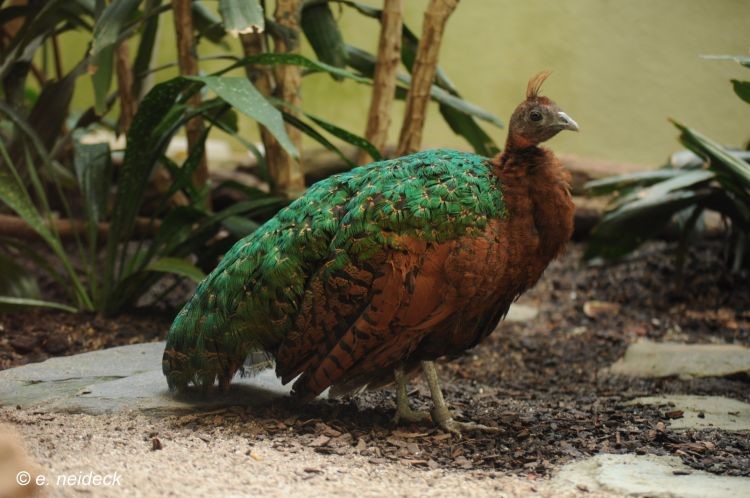
Congo Peafowl, female. (Frankfurt Zoo, Germany; July 13, 2013.) © Elias Neideck

Congo Peafowl, female. (Zoo Dvůr Králové, Czechia; April 28, 2000.) © Martin Antoš
As with males, the female’s facial skin is mostly bare and grayish, with a bare red throat patch that extends down the front of the neck.
Voice. Best known vocalizations are duets of male and female, a frequently repeated, undulating, trumpeting call: Bandundu Province, close to Salonga National Park, Southern Sector; July 21, 2013. © Paul H. Kuchenbuch
Notes
Monotypic species.
IUCN Red List Status: Vulnerable.
References
BirdLife International. 2016. Afropavo congensis. The IUCN Red List of Threatened Species 2016: e.T22679430A92814166. https://dx.doi.org/10.2305/IUCN.UK.2016-3.RLTS.T22679430A92814166.en. (Accessed March 16, 2020.)
eBird. 2020. eBird: An online database of bird distribution and abundance. Cornell Lab of Ornithology, Ithaca, N.Y. http://www.ebird.org. (Accessed March 12, 2020.)
Madge, S., and P.J.K. McGowan. 2002. Pheasants, Partridges, and Grouse: A Guide to the Pheasants, Partridges, Quails, Grouse, Guineafowl, Buttonquails, and Sandgrouse of the World. Princeton University Press, Princeton, N.J.
McGowan, P.J.K., G.M. Kirwan, and C.J. Sharpe. 2020. Congo Peafowl (Afropavo congensis). In: del Hoyo, J., Elliott, A., Sargatal, J., Christie, D.A. & de Juana, E. (eds.). Handbook of the Birds of the World Alive. Lynx Edicions, Barcelona. https://www.hbw.com/node/53523. (Accessed March 16, 2020.)
